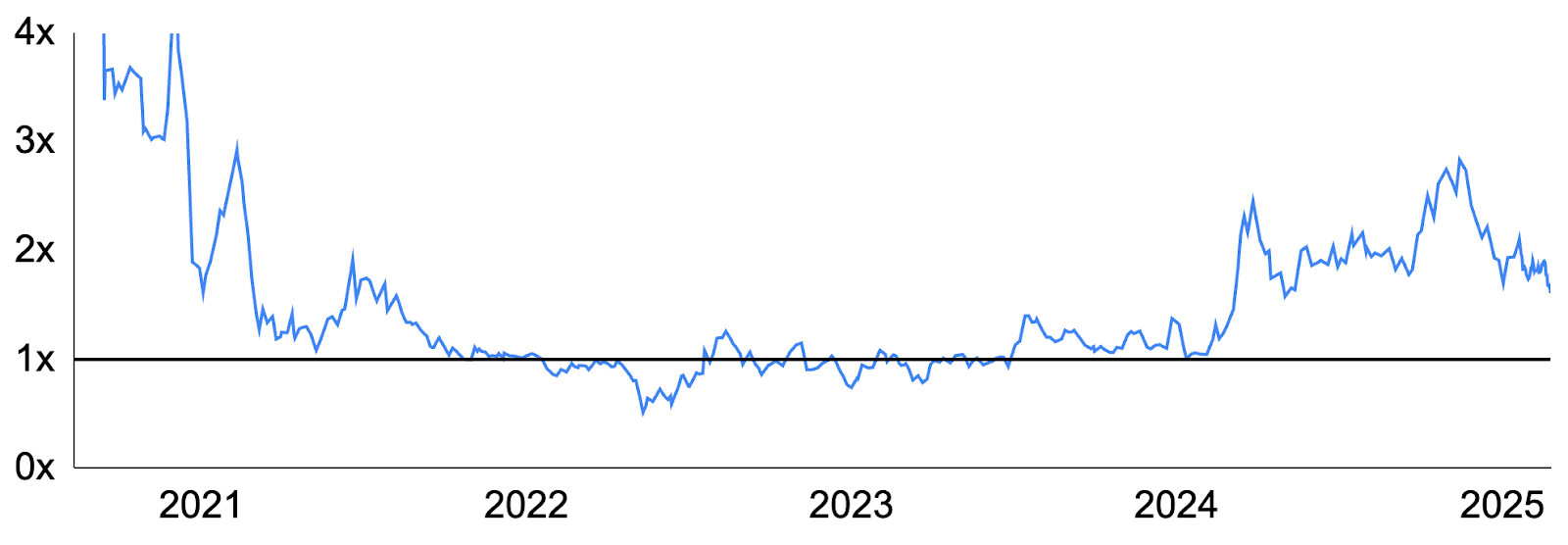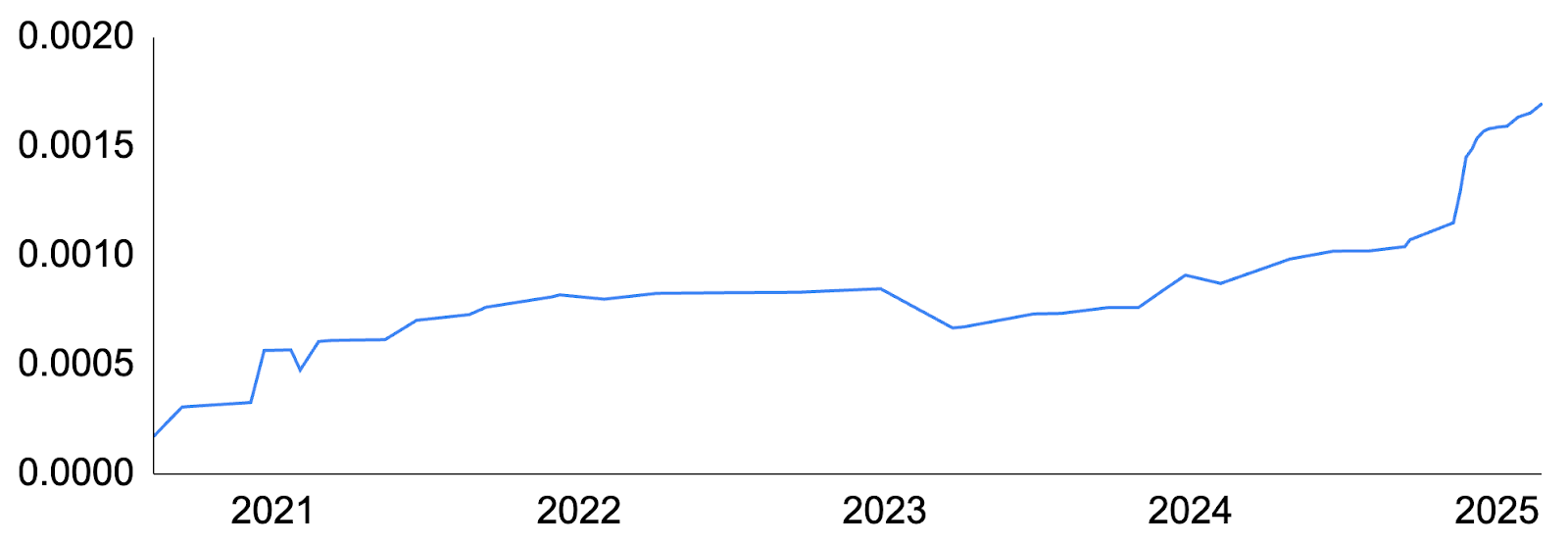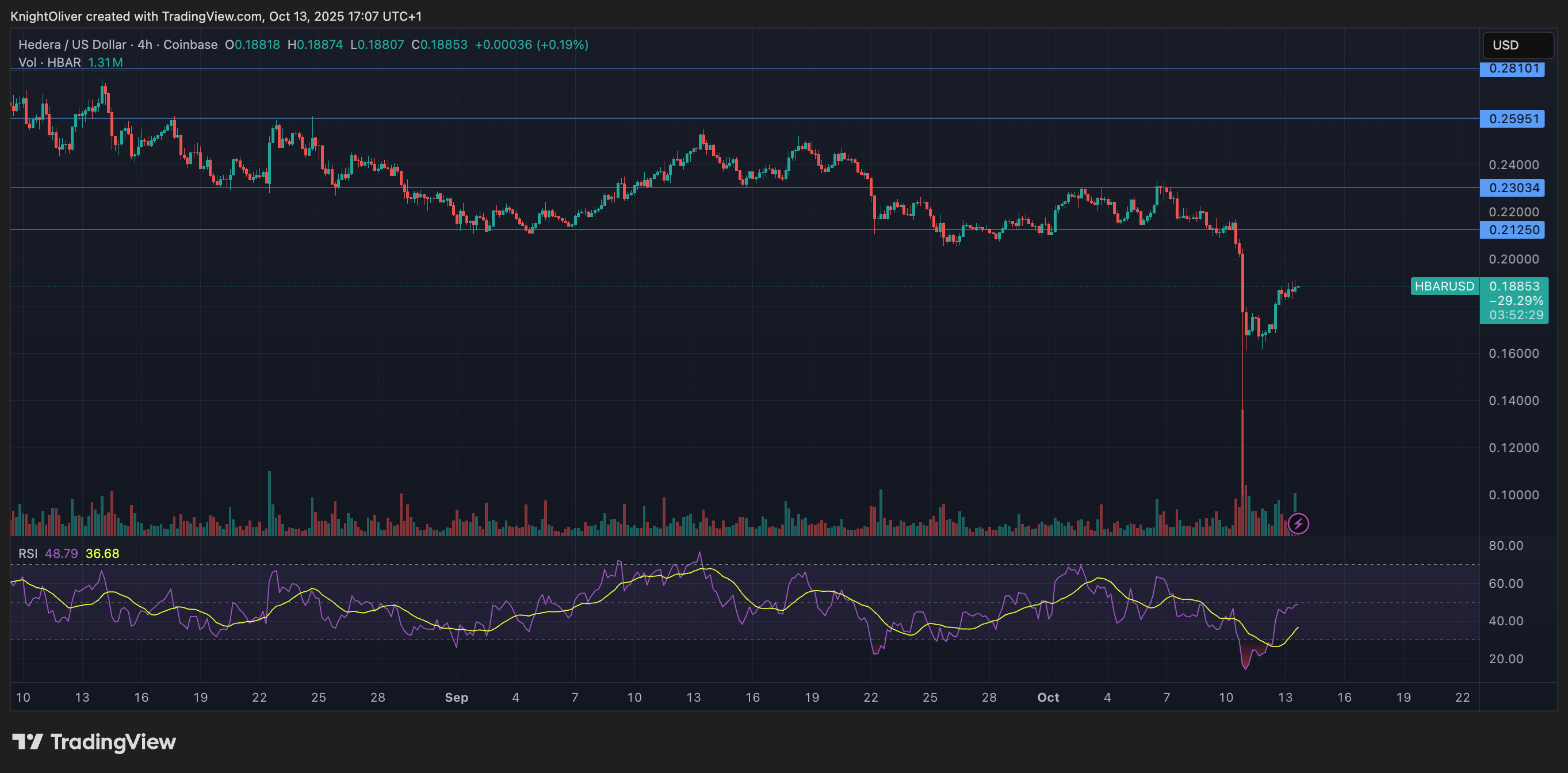Uncategorized
In Defense of the ‘MSTR Premium’

Strategy (NASDAQ: MSTR), the SaaS-based business intelligence company formerly known as MicroStrategy that pioneered a bitcoin treasury strategy, is currently trading at a $73 billion market cap, ~1.6x the value of its underlying bitcoin holdings. This so-called “MSTR premium” has caused much misunderstanding, healthy skepticism and even consternation, but with a decade of deep equities experience, we believe that there are three reasons why the MSTR premium is justified. These are particularly valid during periods of rising bitcoin price expectations, as we are in now.
You’re reading Crypto Long & Short, our weekly newsletter featuring insights, news and analysis for the professional investor. Sign up here to get it in your inbox every Wednesday.
CHART: MSTR’s premium to NAV

Source: MSTR-Tracker.com, GSR
First, Strategy takes on leverage by issuing equity and debt to invest the proceeds into bitcoin, earning the difference between the return on bitcoin and its cost of capital (ie. “carry”). Importantly, Strategy earns this carry not just this year, but also in future years as well, and investors simply present-value this expected future carry and include it in MSTR’s market cap.
In fact, this is a major reason why MSTR’s premium will fluctuate with market expectations of future bitcoin returns. Nevertheless, the first reason MSTR trades at a premium to its BTC holdings is that investors pull future BTC carry to the present.
Second, Strategy monetizes intelligent capital markets issuance for the benefit of shareholders. It accretes value via convertible debt issuance, where it not only gets paid to offer bitcoin-like returns to the bond market, but also for the volatility inherent in its stock as convertible bond arbitrageurs make more money with a more volatile underlying asset. In addition, MSTR issues equity, mostly through at-the-money equity issuance programs, at a premium to book value, which is by definition accretive to shareholders. In fact, issuing equity at twice book value is tantamount to selling $1 for $2, or conversely, buying BTC at 50% off. This is how Strategy was able to generate a 74% increase in the amount of its bitcoin held per share last year, equivalent to 140,630 BTC, or $14 billion of value for shareholders.
Lastly, the entire construct takes advantage of bitcoin and crypto’s nascency, the fact that cryptocurrencies are in secular expansion and that bitcoin’s price has tended to rise over time.
For those not yet convinced, we offer the following thought experiment: If I had a magic bank account with $100 USD in it that paid you a 69% interest rate, how much money would you pay me for that? While the answer may vary from person to person, it is likely much more than $100, meaning that the bank account would trade at a premium to its underlying USD (i.e. NAV).
This is exactly what is happening with MSTR, as it has increased its BTC per share at a 69% annual rate since it began investing in bitcoin in August 2020. This increase in BTC per share (i.e. in-kind yield) is higher during bull markets and lower during bear markets, but it has generally risen over time. And while there is no guarantee that Strategy will continue to increase its BTC per share in the future, MSTR is guiding for a 15%+ increase this year and 6-10% in each of the following two years.
Risks abound, of course — MSTR investors take on basis risk to the price of BTC and the stock tends to move more than bitcoin in both directions. Relatedly, the premium may move up or down in the future, and the stock will likely trade at a discount (i.e., below the value of its bitcoin holdings) during bear markets. But the premium exists because investors believe MSTR will continue to increase the amount of its bitcoin per share in the future, and they are willing to pay up for that now.
CHART: MSTR’s increase in bitcoin per share (i.e. bitcoin yield)

Source: MSTR-Tracker.com, GSR
Business
Strategy Bought $27M in Bitcoin at $123K Before Crypto Crash

Strategy (MSTR), the world’s largest corporate owner of bitcoin (BTC), appeared to miss out on capitalizing on last week’s market rout to purchase the dip in prices.
According to Monday’s press release, the firm bought 220 BTC at an average price of $123,561. The company used the proceeds of selling its various preferred stocks (STRF, STRK, STRD), raising $27.3 million.
That purchase price was well above the prices the largest crypto changed hands in the second half of the week. Bitcoin nosedived from above $123,000 on Thursday to as low as $103,000 on late Friday during one, if not the worst crypto flash crash on record, liquidating over $19 billion in leveraged positions.
That move occurred as Trump said to impose a 100% increase in tariffs against Chinese goods as a retaliation for tightening rare earth metal exports, reigniting fears of a trade war between the two world powers.
At its lowest point on Friday, BTC traded nearly 16% lower than the average of Strategy’s recent purchase price. Even during the swift rebound over the weekend, the firm could have bought tokens between $110,000 and $115,000, at a 7%-10% discount compared to what it paid for.
With the latest purchase, the firm brought its total holdings to 640,250 BTC, at an average acquisition price of $73,000 since starting its bitcoin treasury plan in 2020.
MSTR, the firm’s common stock, was up 2.5% on Monday.
Business
HBAR Rises Past Key Resistance After Explosive Decline

HBAR (Hedera Hashgraph) experienced pronounced volatility in the final hour of trading on Oct. 13, soaring from $0.187 to a peak of $0.191—a 2.14% intraday gain—before consolidating around $0.190.
The move was driven by a dramatic surge in trading activity, with a standout 15.65 million tokens exchanged at 13:31, signaling strong institutional participation. This decisive volume breakout propelled the asset beyond its prior resistance range of $0.190–$0.191, establishing a new technical footing amid bullish momentum.
The surge capped a broader 23-hour rally from Oct. 12 to 13, during which HBAR advanced roughly 9% within a $0.17–$0.19 bandwidth. This sustained upward trajectory was characterized by consistent volume inflows and a firm recovery from earlier lows near $0.17, underscoring robust market conviction. The asset’s ability to preserve support above $0.18 throughout the period reinforced confidence among traders eyeing continued bullish action.
Strong institutional engagement was evident as consecutive high-volume intervals extended through the breakout window, suggesting renewed accumulation and positioning for potential continuation. HBAR’s price structure now shows resilient support around $0.189–$0.190, signaling the possibility of further upside if momentum persists and broader market conditions remain favorable.

Technical Indicators Highlight Bullish Sentiment
- HBAR operated within a $0.017 bandwidth (9%) spanning $0.174 and $0.191 throughout the previous 23-hour period from 12 October 15:00 to 13 October 14:00.
- Substantial volume surges reaching 179.54 million and 182.77 million during 11:00 and 13:00 sessions on 13 October validated positive market sentiment.
- Critical resistance materialized at $0.190-$0.191 thresholds where price movements encountered persistent selling activity.
- The $0.183-$0.184 territory established dependable support through volume-supported bounces.
- Extraordinary volume explosion at 13:31 registering 15.65 million units signaled decisive breakout event.
- High-volume intervals surpassing 10 million units through 13:35 substantiated significant institutional engagement.
- Asset preserved support above $0.189 despite moderate profit-taking activity.
Disclaimer: Parts of this article were generated with the assistance from AI tools and reviewed by our editorial team to ensure accuracy and adherence to our standards. For more information, see CoinDesk’s full AI Policy.
Business
Crypto Markets Today: Bitcoin and Altcoins Recover After $500B Crash

The crypto market staged a recovery on Monday following the weekend’s $500 billion bloodbath that resulted in a $10 billion drop in open interest.
Bitcoin (BTC) rose by 1.4% while ether (ETH) outperformed with a 2.5% gain. Synthetix (SNX, meanwhile, stole the show with a 120% rally as traders anticipate «perpetual wars» between the decentralized trading venue and HyperLiquid.
Plasma (XPL) and aster (ASTER) both failed to benefit from Monday’s recovery, losing 4.2% and 2.5% respectively.
Derivatives Positioning
- The BTC futures market has stabilized after a volatile period. Open interest, which had dropped from $33 billion to $23 billion over the weekend, has now settled at around $26 billion. Similarly, the 3-month annualized basis has rebounded to the 6-7% range, after dipping to 4-5% over the weekend, indicating that the bullish sentiment has largely returned. However, funding rates remain a key area of divergence; while Bybit and Hyperliquid have settled around 10%, Binance’s rate is negative.
- The BTC options market is showing a renewed bullish lean. The 24-hour Put/Call Volume has shifted to be more in favor of calls, now at over 56%. Additionally, the 1-week 25 Delta Skew has risen to 2.5% after a period of flatness.
- These metrics indicate a market with increasing demand for bullish exposure and upside protection, reflecting a shift away from the recent «cautious neutrality.»
- Coinglass data shows $620 million in 24 hour liquidations, with a 34-66 split between longs and shorts. ETH ($218 million), BTC ($124 million) and SOL ($43 million) were the leaders in terms of notional liquidations. Binance liquidation heatmap indicates $116,620 as a core liquidation level to monitor, in case of a price rise.
Token Talk
By Oliver Knight
- The crypto market kicked off Monday with a rebound in the wake of a sharp weekend leverage flush. According to data from CoinMarketCap, the total crypto market cap climbed roughly 5.7% in the past 24 hours, with volume jumping about 26.8%, suggesting those liquidated at the weekend are repurchasing their positions.
- A total of $19 billion worth of derivatives positions were wiped out over the weekend with the vast majority being attributed to those holding long positions, in the past 24 hours, however, $626 billion was liquidated with $420 billion of that being on the short side, demonstrating a reversal in sentiment, according to CoinGlass.
- The recovery has been tentative so far; the dominance of Bitcoin remains elevated at about 58.45%, down modestly from recent highs, which implies altcoins may still lag as capital piles back into safer large-cap names.
- The big winner of Monday’s recovery was synthetix (SNX), which rose by more than 120% ahead of a crypto trading competition that will see it potentially start up «perpetual wars» with HyperLiquid.
-

 Business12 месяцев ago
Business12 месяцев ago3 Ways to make your business presentation more relatable
-

 Fashion12 месяцев ago
Fashion12 месяцев agoAccording to Dior Couture, this taboo fashion accessory is back
-

 Entertainment12 месяцев ago
Entertainment12 месяцев ago10 Artists who retired from music and made a comeback
-

 Entertainment12 месяцев ago
Entertainment12 месяцев ago\’Better Call Saul\’ has been renewed for a fourth season
-

 Entertainment12 месяцев ago
Entertainment12 месяцев agoNew Season 8 Walking Dead trailer flashes forward in time
-

 Uncategorized4 месяца ago
Uncategorized4 месяца agoRobinhood Launches Micro Bitcoin, Solana and XRP Futures Contracts
-

 Business12 месяцев ago
Business12 месяцев ago15 Habits that could be hurting your business relationships
-

 Entertainment12 месяцев ago
Entertainment12 месяцев agoMeet Superman\’s grandfather in new trailer for Krypton





